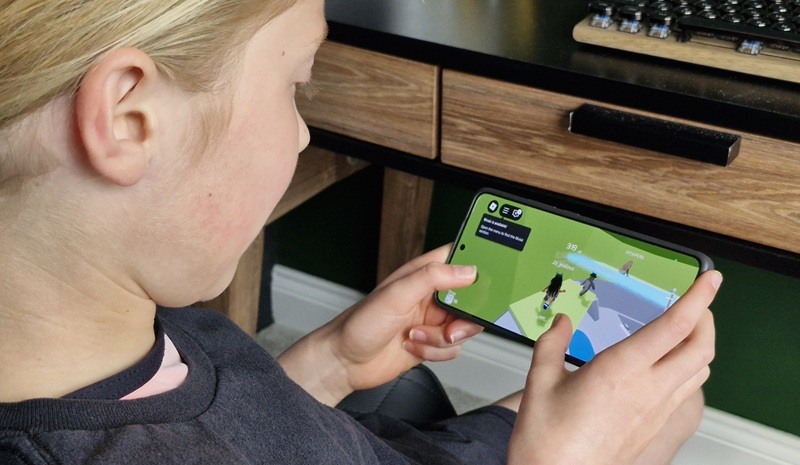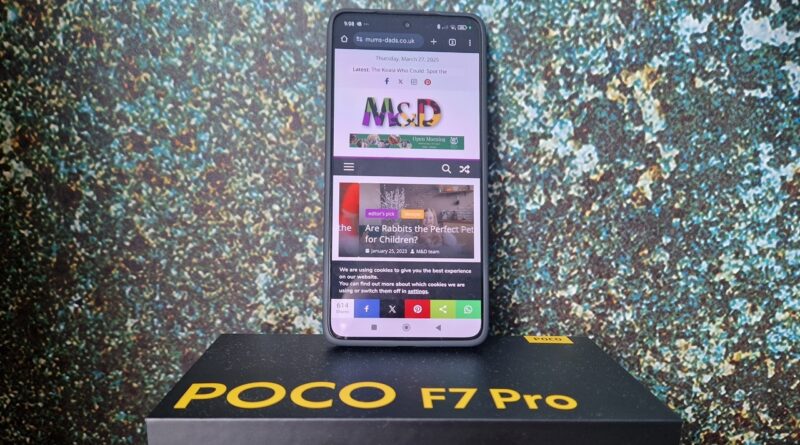Xiaomi POCO F7 Pro Review: An Affordable Premium Phone for the family.
Just before Mother’s Day I wrote for M&D about the new POCO F7 Pro from Xiaomi, which has built up an excellent reputation in the Android market, particularly for power and affordability.
Since I wrote that article, a lot of reviews have been released by tech magazines and websites and the overwhelming consensus has been that this is now the mid-range phone to beat. Tech Advisor writes that the F7 “offers unrivalled £500 performance” and Notebookcheck claims “more smartphone is hardly possible for the price.”
But how does it perform for the average user? Someone who just wants their phone to take great photographs, for their apps to work seamlessly or to use for gaming without lagging; all while standing up to life’s knocks?
I took my review unit with me on a tour of France to put it through its paces. Here’s how it went.
Design and Build Quality
To me, most premium phones look pretty much the same from the front when in sleep mode, and the POCO F7 Pro is no different. The glass looks and feels very sleek and is easily on par with my S range Samsung. The rear looks great, with the top third of the phone boasting a glassy look and the bottom two-thirds having a frosted appearance. The three camera lenses are mounted in a circle, with the flash to the side of that. It looks far more refined than my top-of-the-range Samsung model (see image side-by-side with Samsung S22).

Size-wise, the F7 Pro measures 160.3 x 75 x 8.1 mm and weighs 206g, so is about the same size as the Samsung S23fe. The aluminium frame adds to the premium appearance of the F7 Pro and feels comfortable in your hand, with a reassuring weight to it at the same time.
The device is IP68-rated, ensuring dust and water resistance up to 2.5 meters for 30 minutes. I’m not one for holding my phone under water for 30 minutes at any depth, but what I can say is that on our trip with the POCO F7, I had the phone in deep, melting snow (something that once killed a previous phone of mine) for several minutes. It also accompanied us into the sea in France and in Guernsey, where I filmed him surfing and swimming in the sea. On both occasions, I dried the phone afterwards with a towel, because seawater is never great for any electronic item. But the POCO F7 Pro handled all of these tests perfectly. It also accompanied us for a full day in Aquascope waterpark, where it went down more waterslides than I’d care to mention and spent a good hour in the lazy river with us. Again, all with no issues. I wish I could say the same of all IP68 rated phones, as some have repeatedly given me the dreaded water ingress warning when it came to charging them.
Display
Much has been written about the POCO F7 Pro’s 6.67-inch OLED display, with its 1440 x 3200 resolution and pixel density of approximately 526 PPI. Tech magazines have also complimented the peak brightness of 3200 nits. But, if you’re like me and have no idea what 3200 nits means, I’ll tell you that we had plenty of very sunny days on our trip, and yet the POCO F7 Pro’s screen was always bright enough to clearly see the screen. A great example of this was when we were skiing in the Pyrenees. The sun reflecting on the snow was so bright that without our ski goggles, we were completely dazzled by the light, yet I could still clearly see the screen of the POCO F7 to take pictures.
Watching Netflix on the sharp, vibrant 2K display was a pleasant experience, and the stereo speakers do an equally impressive job, possibly too good a job as I regularly had to ask my ten-year-old daughter, Ella, to turn down the volume when she was watching videos on it.
Storage, battery life, and charging
Speaking of Ella watching movies on the POCO F7 Pro, I was able to store a lot of them on the phone and still have tons of memory left for taking hundreds of photos and videos, thanks to the massive 512GB of storage on the phone. There is also a 256gb version, but that’s still ample storage for most users.
Battery-wise, the POCO F7 Pro is infinitely better than my last flagship phone. One of the things that has plagued me with that phone was the battery life, and it regularly used to run out after less than four hours of screen time, especially when taking photographs. There were no such issues with the POCO F7 Pro, whose 6,000mAh battery seemed to last forever. At first, it took some getting used to having a battery that lasted so long, but after a while I started to forget that it needed charging and not plugging it in overnight. Luckily, the device supports 90W wired charging, and with the included charger, it fully charged from 0% to 100% in approximately 37 minutes!
The only issue I had in this respect is that the unit I received came with a European-style charging plug. This was great for me, as we were in Europe the whole time I was testing the phone, but slightly odd that it didn’t come with a UK plug. It might be that this was because I received a preview model and that it now comes with a UK plug, who knows. But I’ve overcome the issue using an adaptor.
Performance
You might think that with such a long battery life that the POCO F7 Pro comes with a less powerful chipset, but you’d be wrong. It’s powered by the Qualcomm Snapdragon 8 Gen 3 chipset, which is the same chip used in Samsung’s latest flagship phone. The processor is equally impressive, and the POCO F7 Pro just worked seamlessly, with zero lag or functional issues whatsoever, the whole time I was using it, and no matter how many apps or tabs I had open.
Handling the graphics, there is an Adreno 750 GPU, which again coped with everything myself and the kids threw at it with ease. Ella spent a good deal of time playing Roblox on the phone, with the graphics settings at the highest levels, and the F7 Pro had no trouble with this. Likewise, her brother, Harrison, was able to play his Xbox games on the F7 Pro, thanks to the Xbox Game Pass, which allows cloud-based gaming on mobile devices. Again, there were no issues running any of the games, apart from when we were in areas with poor internet connectivity, but this is no reflection on the phone, as cloud-based gaming needs a good internet connection.
Software and user interface

Personally, I think the worst thing about moving from one brand of phone to another is getting used to the new user interface. This is particularly the case when moving from an iPhone to Android, or vice versa. Moving between different Android models is usually more seamless, and this was the case with me switching to Xiaomi’s HyperOS 2.0. The interface is clean and intuitive, so it feels easy to get to grips with. Both kids, aged 13 and 10, found it even easier than I did to make the transition. Harrison is used to his Google Pixel phone, and Ella to my Samsung, and they felt completely at ease with the user interface of the POCO F7 Pro. My only bugbear was that I was scanning a lot of QR codes during the time we were away and that just pointing the camera at QR codes didn’t seem to recognise them. Instead, I had to open an included app called Scanner to scan them. It’s a minor difference, and just as quick to use, but it took some getting used to.
Camera
For me, the camera is one of the most important features of any smartphone and one of the reasons I’ve stuck with Samsung’s S range for as long as I have. I’ve yet to own a phone that can compete with them for photography, and that remains the case after testing the POCO F7 Pro. That’s not to say that the POCO F7 Pro doesn’t take great pictures, because it does, and for the price range the rear cameras are very impressive indeed, delivering sharp, vibrant photos with good dynamic range, especially in daylight. However, the ultrawide lens lacks autofocus and seemed to struggle a little in low light. The lack of a dedicated optical zoom lens is understandable at the price point but is something that I missed from my Samsung S22. But keep in mind that even the iPhone 16 doesn’t have a dedicated optical zoom either, unless you opt for the Pro model, so the F7 Pro is in good company when it comes to using digital cropping as a zoom function when taking pictures.
Where the POCO F7 Pro really excels is the ability to record in 8K on the main camera. The detail and dynamic range on videos from this camera are superb, even in low light. As you’d expect from any camera, video quality drops on the ultra-wide mode and further still on the front-facing selfie camera.
Ultimately the F7’s camera system delivers satisfactory results for everyday photography, it may not compete with flagship models in terms of low-light performance and advanced features but, for its price bracket, it offers commendable quality, particularly for video.
Pricing and value for money
The POCO F7 Pro is competitively priced, with the 12GB RAM and 256GB storage variant available for approximately £399 on Xiaomi’s website or £499 on Amazon. This price point is similar to Samsung’s entry level A series models and Google’s A series models. When it comes to comparing these phones against each other it gets complicated, but I would say that the POCO F7 comes out as number three in the top ten mid-range smart phones for 2025 on Tech Advisor (while Samsung A56 and Google 8a come out at five and eight respectively). Of course, many of us prefer to get our phones with a contract and it could prove harder to find a deal with the POCO simply because of availability.
But if you do buy your phones upfront or find a POCO F7 Pro on contract you’ll get yourself a lot of phone for the money.






